
These past few days, it has been raining quite hard. We love watching heavy downpours when we are staying at home, curled up in a blanket, and having no need to go outside. These heavy rains coincide with the Gu which is the main rainy season (April to June) in Somalia. Back there, we used to love sitting in the veranda, watching and listening to the rain.
Weather like this calls for comfort food and what comfort food is better than Anjero with a nice, aromatic, and deeply flavourful lamb stew. OK, there are some of you out there who have not had lamb or do not like the strong flavour of lamb. Rest assured. This is one lamb dish you really want to try. The aromatic spices, herbs, and the earthy flavour of the root vegetables temper some of the taste of the lamb. Still not convinced? In that case, substitute the lamb with chicken or beef, or make it vegetarian, and you will still end up with a stew that will make your taste buds and tummy really thankful.
This dish is about adding the different ingredients each at its right time. The lamb should be soft and tender, and the vegetables should retain their shape. The potatoes should not be cut into large cubes, since potatoes take longer to soften in acidic liquids like tomato sauces.
As some of you have noticed, we use more oil when cooking stews. The oil is important as it will “fry” the stew and give it a nice, caramelly taste. When the stew is ready, the oil separates and floats at the top, making it very easy to remove. Adding enough oil also helps in preventing the stew from sticking to the pot and burning. That is the rationale for the extra oil we use when cooking stews or tomato sauces in general.
Then it was time to sit down and do what Somalis have been doing for a very long time: scooping the stew on top of Anjero. Wait, do not sit down yet. Turn on some Qaraami music, a Somali musical style played with Kaban (Oud). The word Qaraami comes from the Arabic word غرامي which means romantic. What is most important to know though, is that Qaraami goes really well with maraq (stews).
Apart from Anjero, this stew can also be served with Soor (grits), plain rice, Sabaayad (chapati), or a nice, crusty bread. Somalis would also eat this with pasta and it would make an amazing sauce instead of regular pasta sauce.
Ingredients:
(Tbsp is a tablespoon; tsp is a teaspoon)
(1 cup = 237 mL = 2.4 dl; 1 Tbsp = 15 mL; 1 tsp = 5 mL); all are level measurements
- ⅓ cup (79 mL) Canola oil – Or vegetable oil
- 1 Large Onion (sliced)
- 3 Garlic cloves (minced)
- 1 tsp (5 mL) Fresh ginger (grated)
- 2 tsp (10 mL) Fenugreek seeds (ground)
- 1 Tbsp (15 mL) Xawaash
- 1 tsp (5 mL) Turmeric powder
- 1½ lb (680 g) Lamb – Or goat meat
- 4 Large (800 g) Tomatoes (blended)
- 3 Tbsp (45 mL) Tomato paste
- 2 tsp (10 mL) Salt (to taste)
- 2 Medium (350 g) Potato (cubed)
- 2 Medium (230 g) Carrot(s) (sliced)
- 1 Green pepper (chopped)
- 1 Tbsp (15 mL) Green chilli sauce – Or to taste
- ½ cup (80 g) Cilantro (chopped) – UK: coriander
- ½ tsp (2.5 mL) Ground black pepper
Directions:



- In a pan set on medium heat, saute the onions in the oil for 3 minutes. Add the garlic and fry for one minute then add the ginger and mix well.
- Add the fenugreek, xawaash and turmeric. Mix well after each addition.
- Add the meat right after, so the spices don’t burn. Brown for 3 minutes.
- Add the blended tomatoes and mix.
- Add the tomato paste and stir well. Cover and cook for 30 minutes.
- Add the potatoes and carrots. Cover and cook for another 20 minutes.
- Add the green pepper and cook for 10 more minutes.
- Add the chili sauce and cilantro. Stir well.
- Add the black pepper and stir. Serve hot with anjero.
Mukawinaadka:
(QW waa qaaddo weyn – midda cuntada lagu cuno; qy waa qaaddo yar)
(1 koob = 237 mL = 2.4 dl; 1 QW = 15 mL; 1 qy = 5 mL)
- ⅓ koob (79 mL) Saliid caddeey
- 1 Basal , Weyn (jarjaran)
- 3 Tuun (toon) (shiidan)
- 1 qy (5 mL) Sanjabiil cusboon (la xoqay)
- 2 qy (10 mL) Xulbad (shiidan)
- 1 QW (15 mL) Xawaash
- 1 qy (5 mL) Huruud shiidan
- 1½ baawun (680 g) Hilib idaad (ari)
- 4 (800 g) Yaanyo , Weyn (shiidan)
- 3 QW (45 mL) Yaanyo shiishiid
- 2 qy (10 mL) Cusbo (inta dooqaaga ah)
- 2 (350 g) Bataato / baradho , Dhexdhexaad ()
- 2 (230 g) Karooto (dabacase) , Dhexdhexaad (jarjaran)
- 1 Barbarooni cagaaran (jarjaran)
- 1 QW (15 mL) Basbaas cagaar shiidan
- ½ koob (80 g) Kabsaro caleen (jarjaran)
- ½ qy (2.5 mL) Filfil madoow shiidan
Diyaarinta:



- Digsi dab dhexdhexaad ah saaran saliidda ku shub. Basasha dallac muddo 3 daqiiqo. Ku dar tuunta (toonta), hal daqiiqana shiil. Sanjabiisha ku dar, si fiicanna u walaaq.
- Ku dar xulbadda, xawaashka iyo huruudda. Walaaq mid walba markaad ku dartid.
- Hilibka ku dar, walaaqna ilaa uu ka gaduuto, muddo 3 daqiiqo.
- Yaanyada ku dar ee si fiican u walaaq.
- Yaanyo shiishiidka ku dar, kaddibna walaaq. Dabool ha karo muddo 30 daqiiqo.
- Bataatada iyo karootada ku dar. Dabool ha karo muddo 20 daqiiqo.
- Barbarooniga ku dar, 10 daqiiqo oo kalena kari.
- Basbaaska iyo kabsara caleenta ku dar.
- Filfisha madoow ku dar, si fiicanna u walaaq. Maraqa kulul canjeero ama soor ku cun.
المقادير
كوب = 237 مل، ملعقة كبيرة = 15 مل، ملعقة صغيرة = 5 مل
| زيت الكانولا | كوب | ⅓ |
| (بصل( مقطع شرائح | 1 | |
| (فص ثوم( مفروم | 3 | |
| (زنجبيل طازج( مبشور | ملعقة صغيرة | 1 |
| (حبوب الحلبة( مطحون | ملعقة صغيرة | 2 |
| حوائج | ملعقة كبيرة | 1 |
| مسحوق الكركم (الهرد) | ملعقة صغيرة | 1 |
| خروف/ | جم | 680 |
| (طماطم( مضروبة في الخلاط | جم | 800 |
| معجون طماطم | ملعقة كبيرة | 3 |
| (ملح( حسب الرغبة | ملعقة صغيرة | 2 |
| (بطاطا( مكعبة | جم | 350 |
| (جزر( مقطع شرائح | جم | 230 |
| فلفل اخضر/ فلفل رومي | 1 | |
| البسباس الاخضر | ملعقة كبيرة | 1 |
| كزبرة | جم | 80 |
| فلفل اسود مطحون | ملعقة صغيرة | ½ |
طريقة التحضير:



| فى قدر على نار متوسطة يحمر البصل فى الزيت لمدة 3 دقائق، يضاف الثوم ويحمر لمدة دقيقة واحدة، ثم يضاف الزنجبيل ويحرك جيدا | -1 |
| تضاف الحلبة، الحوائج (بهارات مشكلة) ومسحوق الكركم (الهرد) ويحرك جيدا | -2 |
| يضاف اللحم، يحرك ويحمر لمدة 3 دقائق | -3 |
| تضاف الطماطم ويحرك جيدا | -4 |
| يضاف معجون الطماطم ويحرك المرق جيدا ثم يغطى ويطهى لمدة 30 دقيقة | -5 |
| يضاف البطاطس والجزر، يغطى المرق ويطهى لمدة 20 دقيقة اخرى | -6 |
| يضاف الفلفل الاخضر، يغطى ويطهى لمدة 10 دقائق | -7 |
| يضاف صوص البسباس والكزبرة | -8 |
| يضاف الفلفل الاسود ويحرك جيدا، يقدم المرق ساخنا | -9 |
]]>
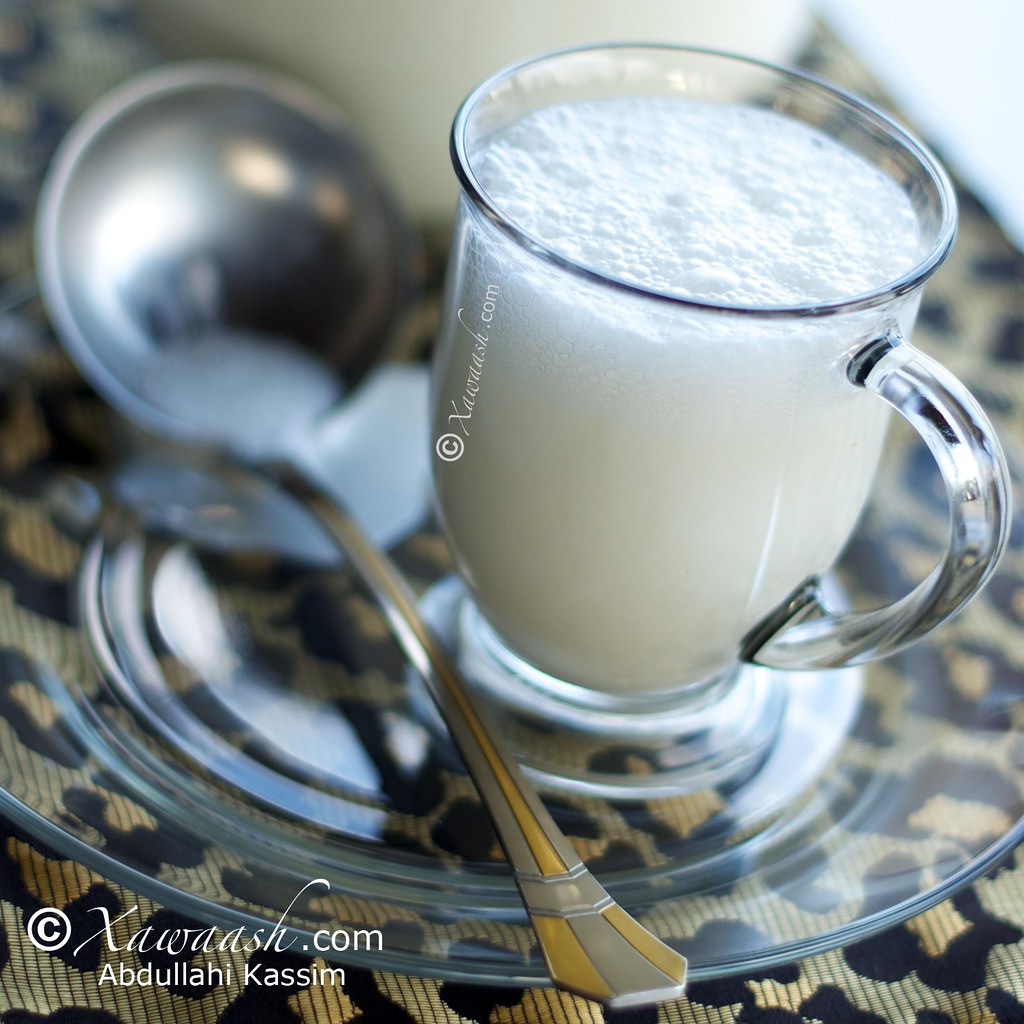
The Horn of Africa boasts the largest number of camels in the world. Camels have been domesticated in Somalia for more than 2000 years. In an article in Aramco World, the Somali camel has been described as follows:
“The Somali camels seem by far the most regal, and they are the most expensive. Looking down with their beautiful dark eyes from their height of 2½ to 3 meters (8 to 10 feet) above the ground, they seem to regard humans as inferior beings, hardly worth considering.”
Somalis prize their camels and countless poems were penned singing their praises. Pastoral Somalis depend on the camel to survive the harsh conditions of a mainly arid land. Camel herders are known to survive on camel milk only, for weeks on end. There is a Somali proverb that says, “A mouthful of camel’s milk keeps you going for half a day.” (Axmed Cali Abokor, The Camel in Somali Oral Traditions, 1987)
The Somali poet, Omar Hagi Hussein (Australia), said:
Dhibaatiyo adoo gaajo qaba dhaxanta jiilaalka, When the cold, dry winds compound your hunger and hardship
Dhoor caano laga soo lisoo yara dhanaanaaday And there is the slightly fermented milk from your favourite camel
Nin dhadhamiyey wuu garanayaa dhul ay qaboojaane Whoever gets a taste, knows whence the hunger was quenched
Goortaad dhantaa baa jidhkaba dhididku qooyaaye When you drink it, you break in sweat, defying the cold winds
Ragga laxaha sii dhawrayoow dhaqasho waa geele! To those who tend to sheep, “Realize: It’s camels that are worth
rearing!”
Camel milk is a powerful healer, a diet in and of itself, and is amazingly delicious. Nothing beats real camel milk, and it is one of those things that Somalis living abroad, really miss. Those who long for camel milk have devised ways of simulating the texture and flavour of camel milk and each person has a recipe of his own.
After much experimentation, this is the recipe we settled on and it has become a hit with those who tried it. Camel Milk is low fat and this recipe stays true to that.
The milk we tried to replicate is not the fresh camel milk. Our favourite camel milk is the soured and slightly-curdled type.
La Corne de l’Afrique se vante d’abriter le plus grand nombre de chameaux du monde. En Somalie, les chameaux sont domestiqués depuis plus de 2000 ans. Dans un article de Aramco World, le chameau Somali est décrit comme ceci:
“Les chameaux Somalis sont de loin les plus majestueux, et ont le plus de valeur. Ils nous observent avec leurs beaux yeux noirs depuis leur hauteur de 2,5 à 3 mètres (8 à 10 pieds) au dessus du sol, ils semblent regarder les humains comme des être inférieurs, à peine dignes de leur attention.”
Les chameaux sont très précieux pour les Somalis et de nombreux poèmes ont été écrits pour chanter leurs louanges. Les pasteurs Somalis dépendent des chameaux pour survivre dans les condition difficiles sur une terre majoritairement aride. Les gardiens de troupeaux sont connus pour survivre uniquement avec du lait de chameau, pendant plusieurs semaine d’affilée. Il existe un proverbe Somali qui dit: “Une gorgée de lait de chameau vous nourrit pour une demie journée”. (Axmed Cali Abokor, le chameau dans les traditions orales Somali, 1987).
Le Poète Somali, Omar Hagi Hussein (Australia), a écrit:
Lorsque les vents froids et secs aggravent votre faim et vos privations
et qu’il y a du lait légèrement fermenté de votre chameau préféré
Celui qui en goûte, sait que sa faim touche à sa fin
Quand vous en buvez, vous transpirez, vous résistez aux vents glacés
A ceux qui élèvent des moutons, “Sachez-le: Ce sont les chameaux qui valent la peine d’être élévés!”
Le lait de chameau est un reconstituant puissant, un aliment complet, et est incroyablement délicieux. Rien ne peut remplacer le lait de chameau et c’est une des choses qui manquent le plus aux Somalis qui vivent à l’étranger. Beaucoup ont mis au point une formule pour reproduire la texture et la saveur du lait de chameau et chaque personne à sa recette personnelle.
Après beaucoup d’expérimentation, c’est cette recette que nous avons retenue et qui est devenue un succès auprès de tous ceux qui l’ont essayée. Le lait de chameau est pauvre en graisses et cette recette l’est aussi.
Le lait que nous avons essayé de reproduire n’est pas le lait de chameau frais. Notre lait de chameau favori est celui qui est aigre et légèrement caillé.
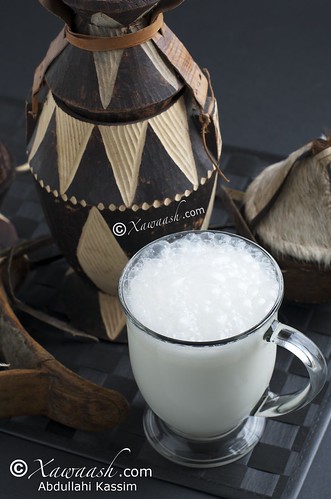
Ingredients:
1 litre Buttermilk
1 tub (750 g) 1% Yoghurt
2 cups Sprite or 7UP
¼ tsp Salt (optional)
3 tbsp Sugar to taste (optional)
Waxa loo baahan yahay :
(QW waa qaaddo weyn – midda cuntada lagu cuno; qy waa qaaddo yar)
(1 koob = 237 mL = 2.4 dl; 1 QW = 15 mL; 1 qy = 5 mL)
1 litir Caano garoor
1 caag (750 g) 1% Caano fadhi
2 koob Sprite ama 7UP
¼ qy Cusbo (haddaad jeceshahay)
3 QW Sokor (ama inta aad jeceshahay)
Ingrédients:
1 litre de Babeurre
1 pot (750 g) de Yaourt 1%
2 mesures de Sprite ou 7UP
¼ cc de Sel (optionnel)
3 cs de Sucre ou selon le goût (optionnel)
Directions:
Use a blender or an immersion blender. Mix the buttermilk, yoghurt, sugar and salt. Mix in the Sprite just before serving. Avoid adding ice. For best results, prepare it a day ahead and let it cool in the fridge.
Waxaad isticmaashaa qallaad (makiinadda wax shiidda) ama qallaadka gacanta. Isku qas caanaha garoorta, caana fadhiga, sokorta iyo cusbada. Ku-dar Sprite-ka intaadan qaddimin. Isku day baraf inaadan ku-darin. Caanaha waxay ku-fiican yihiin maalin ka-hor in laqaso oo qaboojiyaha loo daayo.
Utiliser un blender ou un pied mixer. Mixer le babeurre, le yaourt, le sucre et le sel. Mélanger le Sprite juste avant de servir. Éviter d’ajouter de la glace. Pour de meilleurs résultats, préparer un jour avant et faire refroidir dans le réfrigérateur.
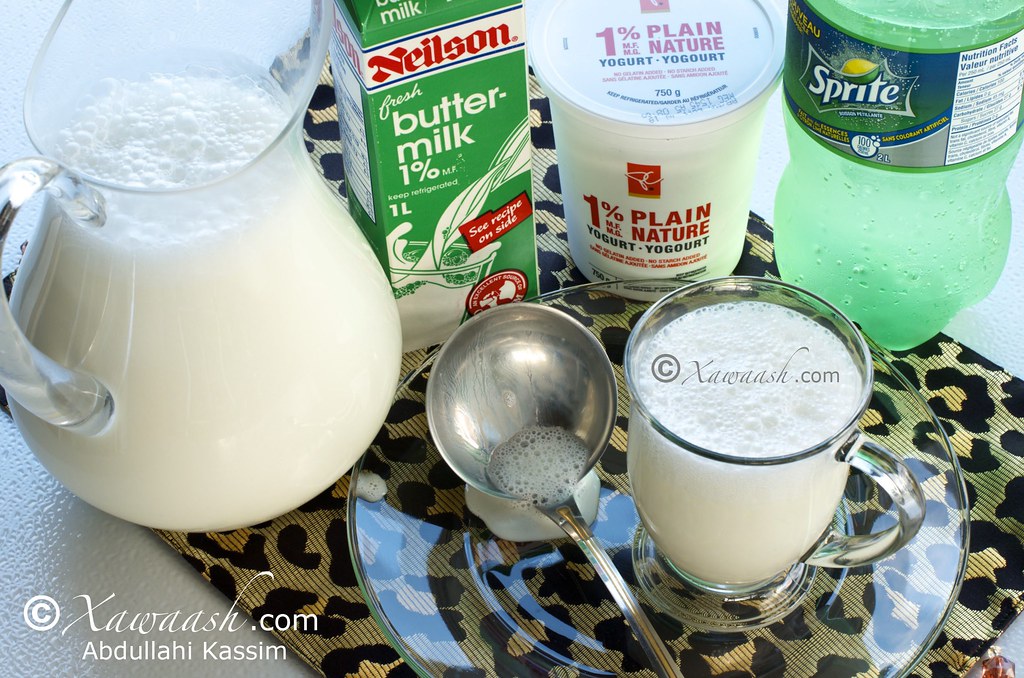


Nomade Somali trayant son chameau (Photo “Luci della Somalia”)

Nomade Somali buvant du lait de chameau frais (Photo “Luci della Somalia”)

Au point d’eau (Photo “Luci della Somalia”)

Nomade Somali et son chameau (Photo “Luci della Somalia”)

Chargement du chameau (Photo “Luci della Somalia”)

Chameaux buvant leur ration d’eau pour le mois (Photo “Luci della Somalia”)
]]>
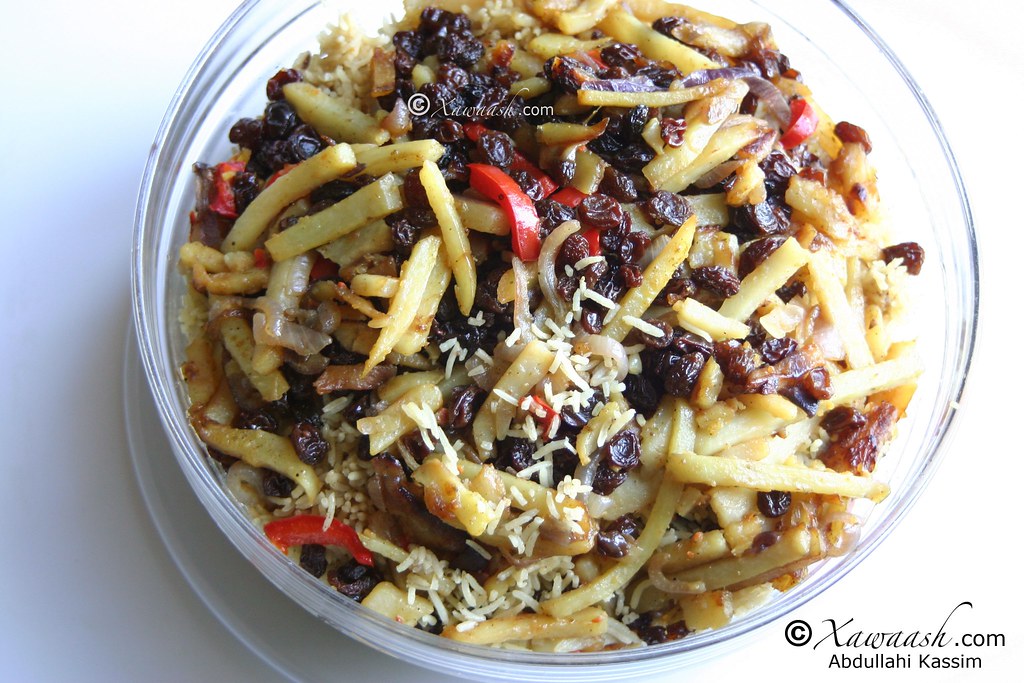
Somali rice with toppings evokes old memories of family gatherings, and festive occasions. It reminds me particularly of ziyaras (rememberences) where large numbers of women gather to cook rice and meat in huge pots set on open fires.
I remember my grandparents’ house in Mogadishu, where a ziyara was held once a year to commemorate our great, great grandfather. He was said to have been a pious person who was generous to the poor. So on that day, the gates were open to everyone and the poor came there to be served by the family members. I remember everyone sitting on mats on the floor, strangers and the relatives, all eating from the same plate.
All the cooking was done in the huge yard that was half overtaken by bushes. The women, who were preparing the food, were divided into teams, and duties were assigned for peeling the onions and garlic, cutting the potatoes and peppers, cooking the meat, and preparing the stock for the rice. There was also a team that was in charge of the camel milk, a must have for ziyaras.
The yard was like a beehive with women scurrying around, cheerfully going about their assigned duties. In the midst of all of this, we played with other kids and caused mischief. Happy memories…
Le riz Somali et ses garnitures nous évoque de vieux souvenirs de rassemblements de famille, et d’occasions festives. Il me rappelle particulièrement les zirayas (commémorations) où un grand nombre de femmes se rassemblaient pour cuire du riz et de la viande dans de grandes marmites sur des feux en plein air.
Je me rappelle la maison de mes grands-parents à Mogadishu, où un ziyara se tenait chaque année en mémoire de notre arrière, arrière grand-père. Il était reconnu comme étant une personne très pieuse qui était généreuse envers les pauvres. Alors pour ce jour, les grilles étaient ouvertes à tous et les pauvres venaient pour être servis par les membres de la famille. Je me rappelle de tout le monde réuni assis sur des tapis par terre, inconnus et proches, tous mangeant dans le même plat.
Toute la cuisine était préparée dans le jardin qui était à moitié envahi par les buissons. Les femmes, qui préparaient la nourriture, étaient regroupées en équipes, et les tâches étaient assignées de peler les oignons et l’ail, couper les pommes de terre et les poivrons, cuire la viande, et préparer le bouillon pour le riz. Il y avait aussi une équipe qui était chargée du lait de chameau, indispensable pour les ziyaras.
Le jardin était comme une ruche de femmes s’affairant, qui accomplissaient leurs tâches joyeusement. Au milieu de tout ça, nous jouions avec les autres enfants et faisions des bêtises. De bons souvenirs…
Ingredients:
5 Tbsp Vegetable oil (drain after sauteeing)
2 Large onions (sliced)
3 Potatoes (cut into even strips)
1 Red pepper (sliced)
1 cup Raisins
½ Tbsp Vegetable seasoning salt
¼ tsp Xawaash (click on link)
Waxa loo baahan yahay:
5 QW Saliid caddeey
2 Basal waaweyn (jarjaran)
3 Bataato (baradho) (dhaadheer is-la’eg loo jaray)
1 Barbarooni gaduudan (jarjaran)
1 koob Sabiib
½ QW Maraq qudaar (Vegeta)
¼ qy Xawaash (halkaan guji)
Ingrédients:
3 Pommes de Terre (vous pouvez utiliser des frites surgelées)
2 Gros Oignons (Émincés)
1 Poivron Rouge (Émincé)
1 Mesure de Raisins Secs
½ cs de Condiment Légumes
¼ cc de Xawaash (cliquez sur le lien)
5 cs d’Huile Végétale (égoutter après la cuisson)
2 cs de Pignons de pin (optionnel)
Une pincée de colorant alimentaire jaune
Directions:
Cut the vegetables.
Qudaarta jarjar.
Instructions:
Couper les légumes.
Heat the oil using medium heat. Add the onions, cook for two minutes. Add the cut potatoes, cover and cook for 10 minutes. Add the red pepper and the Xawaash. Mix well; turn off the heat then add the raisins.
Bir dab dhexdhexaad saaran saliidda kushub. Basasha ku-dar, laba daqiiqo shiil. Bataatada ku-dar, dabool ee 10 daqiiqo kari. Barbarooniga iyo Xawaashka ku-dar. Si-fiican u-walaaq, kaddibna dabka ka-deji; sabiibka ku-dar.
Faire chauffer les épices dans l’huile. Ajouter le colorant jaune sur les pommes de terre égouttées. Verser les pommes de terre dans la poêle jusqu’à ce qu’elles soient à moitié cuites. Ajouter les oignons, puis deux minutes après ajouter le poivron rouge.
Une fois que les légumes sont tendres quand piqués à la fourchette, couper le feu et ajouter les raisins secs. Mélanger délicatement.
Place the mixture in a colander (with a plate underneath) to drain the oil.
Baasta miire ku-geddi, si ay saliidda uga miiranto.
Mettre le mélange dans une passoire (posée sur une assiette) pour égoutter l’huile.

]]>
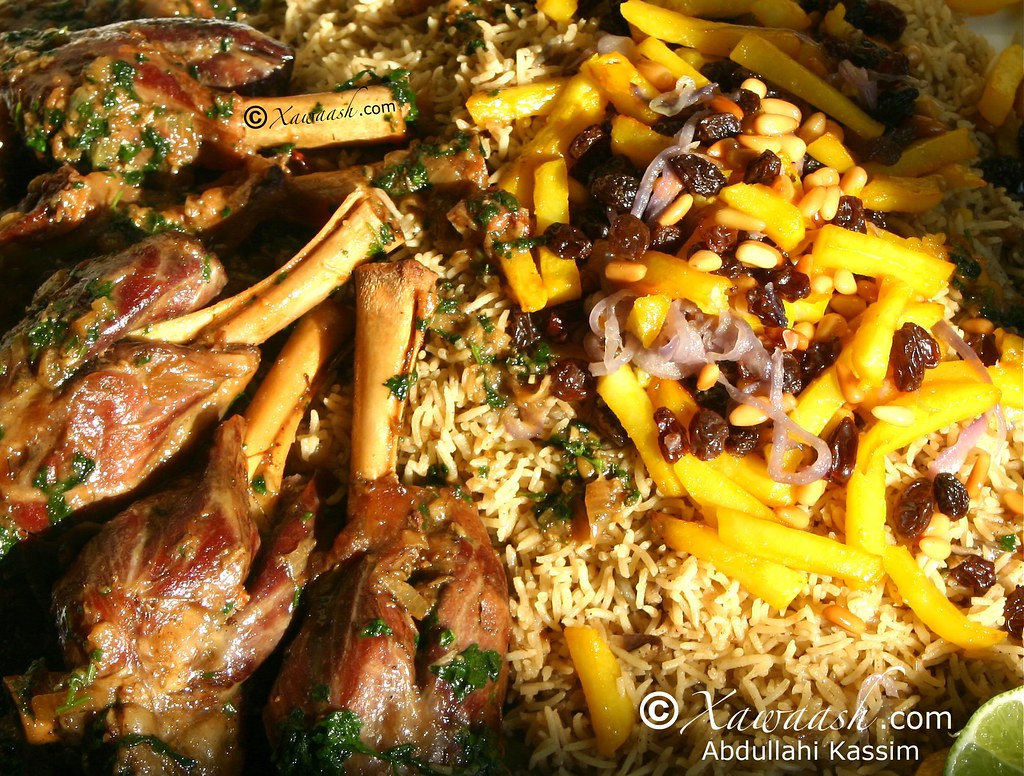
Tender meat cooked to perfection and served with Somali rice. You can cook this dish either with lamb shanks or goat shanks. Goat meat has a milder taste than lamb.
We used a pressure cooker to cook the meat quickly, but you can cook it slowly in a slow cooker or in a regular pot until the meat becomes fork tender and starts to fall off the bones. The resulting sauce is incredibly flavourful.
We didn’t add any other vegetables because the Somali rice is usually served with a topping of vegetables.
This is a fancy and delicious dish yet simple at the same time.
Cette viande est tendre quand elle est cuite à la perfection, et se sert avec du riz Somali. Vous pouvez réaliser ce plat avec soit du jarret d’agneau soit du jarret de chevreau. La viande de chevreau a un goût moins prononcé que l’agneau.
Nous avons utilisé un autocuiseur pour cuire la viande rapidement, mais vous pouvez la cuire lentement dans une cocotte ou dans une marmite normale jusqu’à ce que la viande soit tendre et commence à se détacher. La sauce qui en résulte est incroyablement goûteuse.
Nous n’avons pas ajouté de légumes car le riz Somali est servi avec une garniture de légumes.
C’est un plat sophistiqué et délicieux mais simple en même temps.
Ingredients:
Serves 4
4 Lamb or goat shanks
1 Large onion (diced)
8 Garlic cloves (crushed)
6 Tbsp Canola oil (or any other vegetable oil)
1 Tbsp Vegetable seasoning (we used Vegeta Seasoning Mix; you can use vegetable stock or bouillon cubes)
1 tsp Xawaash
¼ tsp Ground cinnamon
¼ cup Fresh cilantro (chopped)
2 Tbsp White vinegar
2 cups Water (5 cups if not using a pressure cooker)
Waxa loo baahan yahay:
Ku-filan 4 qofood
4 Duubi
1 Basal weyn (la-jarjay)
8 Tuun (toon) shiidan
6 QW Saliid caddeey
1 QW Maraq qudaar (Vegeta) ama 2 mukacab Maggi ama Knorr
1 qy Xawaash
¼ qy Qorfe shiidan
¼ koob Kabsara caleen (jarjaran)
2 QW Qal cad
2 koob Biyo (5 koob haddaadan digsi fuufle “pressure cooker” isticmaalaynin)
Ingrédients:
Pour 4
4 Souris d’Agneau ou de Chevreau
1 Gros Oignon (coupés en dés)
8 Gousses d’Ail (écrasées)
6 cs d’Huile de Colza (ou tout autre huile végétale)
1 cs de Condiment Légumes (nous avons utilisé le mélange Vegeta; vous pouvez utiliser du bouillon de légumes ou des bouillon cubes)
1 cc de Xawaash
¼ de cc de Cannelle en Poudre
¼ de mesure de Coriandre Frais (haché)
2 cc de Vinaigre Blanc
2 Mesures d’Eau (5 mesures si vous n’utilisez pas un autocuiseur)
Wash the lamb shanks
Hilibka dhaq
Laver les souris d’agneau

Brown the onions, garlic, and spices with the oil. Then add the lamb shanks.
Basasha, tuunta iyo carafta isku dalac. Hilibka ku-rid.
Faire dorer les oignons, l’ail et les épices dans l’huile. Puis ajouter les souris d’agneau.

Add the vinegar and water.
Biyah iyo qalka ku-dar.
Ajouter le vinaigre et l’eau.
Cook on medium heat for half an hour. If not using a pressure cooker, cook for about 2 hours until fork tender. Add the cilantro before turning off the heat.
Dab dhexdhexaad ah ku-kari muddo nus saac. Haddaadan digsi fuufle (pressure cooker) isticmaalaynin, 2 saacadood kari ilaa uu hilibka ka-jilco. Kabsaro caleenta ku-dar intaadan dabka ka-dejin.
Cuire à feu moyen pendant une demie heure.

The lamb shanks. Fork tender and cooked to perfection.
Hilibka oo si-fiican u-bislaaday.
Les souris d’agneau. Tendre et cuites à la perfection.

Serve with Somali rice and, most important of all, do not forget the banana!
Bariis ku-cun, muuskana haka ilaawin.
Servir avec du riz Somali, et très important, ne pas oublier la banane!


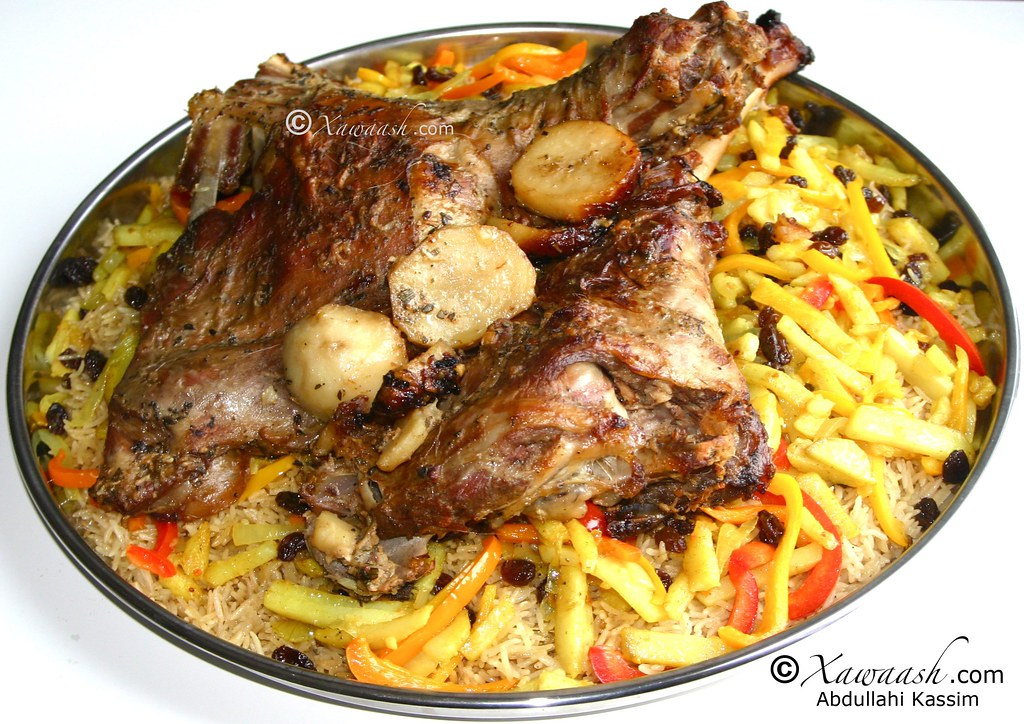
We have tried rice dishes from different parts of the world and we had some nice experiences. One thing, however, never fails to amaze us. It is how delicious Somali rice is, considering that it is not a staple food in Somalia. Yes, Somali restaurants serve rice, but for the majority of Somali households in urban areas, pasta is what is consumed on a daily basis. In villages and rural areas across Somalia, the main food is Soor (grits) made of either corn or sorghum.
Yet when Somalis invite guests to their home, they serve them rice. Huge platters of rice, flavoured with spices that compliment the natural aroma of the rice. The rice is garnished with Somali Rice Topping (a unique blend of vegetables, raisins and Xawaash). Then on top of that is the crowning glory: chunks of delicious goat meat. Yum!
It is a feast for the eyes. Then you dig in, literally. Forget about the spoon and fork. They have yet to invent an implement that is better than a hand, that can rip a piece of meat, cut a slice of banana, and scoop some rice in one fell swoop.
Nous avons goûté des plats de riz de différentes parties du monde et toujours avec plaisir. Une chose, cependant nous étonne toujours. C’est que le riz à la Somali est vraiment délicieux, d’autant plus qu’il n’est pas un aliment commun en Somalie. Oui, les restaurants Somalis servent du riz, mais la plupart des foyers Somalis en zones urbaines, ce sont les pâtes qui sont consommées quotidiennement. Dans les villlages et les zones rurales de Somalie, la nourriture principale est Soor (gruau) de maïs ou de sorgho.
Pourtant quand les Somalis ont des invités à la maison, ils leurs servent du riz. De grands plats de riz, parfumés aux épices qui se mettent en valeur l’arôme naturel du riz. Le riz est accompagné de Garniture pour riz Somali (un mélange unique de légumes, raisins secs et Xawaash). Et au dessus de tout ça la cerise sur le gâteau: des morceaux de délicieuse viande de chèvre. Yum!
C’est un régal pour les yeux. Puis vous attaquez. Pas besoin de cuillère et de fourchette. Il reste encore à inventer un instrument plus efficace qu’une main, qui peut déchirer un morceau de viande, couper une tranche de banane, et ramasser du riz en un seul geste.
Ingredients:
3 cups Long grain basmati rice
1 Onion (diced)
4 Garlic cloves (minced)
3 Tbsp Canola oil (or any other vegetable oil)
2 Tbsp Butter (optional)
1 Tbsp Vegetable seasoning salt or (Maggi)
½ tsp Xawaash (click on link)
1 stick Cinnamon
¼ tsp Ground cardamom
4.5 cups Lamb stock (see recipe below)
Lamb stock:
¼ lb Lamb (or goat) riblets or any inexpensive lamb pieces with bones
1 Onion (diced)
3 Garlic cloves (minced)
2 tbsp Canola oil (or any other vegetable oil)
½ tbsp Vegetable seasoning salt or (Maggi)
6 Cardamom pods
1 stick Cinnamon
½ tsp Whole black peppers
7 cups Water
Waxa loo baahan yahay:
3 koob Bariis basmati
1 Basal (la-jarjaray)
4 Tuun ama toon (shiidan)
3 QW Saliid caddey
2 QW Buuro ama subag (waad ka-dhaafi kartaa)
1 QW Maraq qudaar (Vegeta) ama (Maggi)
½ qy Xawaash (meeshaan guji)
1 qori Qorfe
¼ qy Hayl shiidan
4.5 Koob Maraq hilib ari (soo’da hoos ka-fiiri)
Maraq hilib ari:
¼ lb Hilib ari
1 Basal (la-jarjaray)
3 Tuun ama toon (shiidan)
2 QW Saliid caddey
½ QW Maraq qudaar (Vegeta) ama (maggi)
6 xabo Hayl
1 qori Qorfe
½ qy Filfil madoow
7 koob biyo
Ingrédients:
3 mesures de Riz Basmati long grain
1 Gros Oignon (en dés)
4 Gousses d’Ail (hachées)
3 cs d’Huile de Colza (ou huile végétale)
2 cs de Beurre (optionnel)
1 cs de Condiment Légumes
½ cc de Xawaash (cliquer sur le lien)
1 bâton de Cannelle
¼ de cc de Cardamome moulue
3 mesures de Bouillon d’Agneau (voir la recette ci-dessous)
Bouillon d’Agneau:
¼ de livre de côtes d’Agneau (ou chevreau) ou tout bas morceau d’agneau avec l’os
3 Gousses d’Ail (hachées)
2 cs d’Huile de Colza (ou huile végétale)
½ cs de Condiment Légumes
6 Gousses de Cardamome
1 Bâton de Cannelle
½ cc de Poivre Noir en grains
5 mesures d’Eau
Directions:
Prepare the lamb stock. Sauté the onions, garlic, and the spices in the oil. Add the meat and cook for about 2 minutes then add the water. Let it simmer until the stock reduces to about 4.5 cups.
Sida loo kariyo:
Diyaari maraqa hilibka ari. Basasha saliidda ku-dalac, tuunta iyo carcarafta ku-dar. Hilibka ku-rid isku walaaq muddo 2 daqiiqo. Biyaha ku-shub. Kari ilaa maraq oo 4.5 koob ah uu ka-haro.
Instructions:
Préparer le bouillon d’agneau. Faire sauter les oignons, l’ail, et les épices dans l’huile. Ajouter la viande et cuire pendant 2 minutes puis ajouter l’eau. Laisser mijoter jusqu’à ce que le bouillon ait réduit à 3 mesures.

While the stock is reducing, wash the rice until the water runs clear. Then soak the rice in cold water for half an hour.
Maraqa intuu ka-karaayo, bariiska si-fiica u-dhaq. Biyo qaboow la-dhig muddo nusu saac.
Pendant que le bouillon réduit, laver le riz jusqu’à ce que l’eau soit claire. Puis tremper le riz dans l’eau froide pendant une demi-heure.
Basasha saliidda ku-dalac, tuunta ku-dar, carafta ku-dar. Bariiska oo biyaha aad ka-miirtay ku-dar. Shiil muddo 5 daqiiqo. Maraqa aad miirtay ku-shub. Si-fiican u-walaaq. Dab yar ku-kari muddo nusu saac ama ilaa uu ka-bislaado.
Utiliser une grande casserole peu profonde (sauteuse) pour que le riz cuise uniformément. Faire sauter les oignons, l’ail, et les épices dans l’huile et le beurre. Quand les oignons deviennent translucides, ajouter le riz essoré et cuire pendant 5 minutes.
Utiliser un tamis pour verser le bouillon chaud sur le mélange de riz. Ajouter la viande. Couvrir la casserole et cuire à feu doux pendant une demi-heure. Ne pas ouvrir le couvercle et laisser sortir la vapeur.













